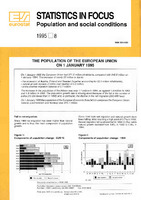| dc.description.abstract | On 1 January 1995 the European Union had 371.5 million inhabitants, compared with 348.6 million on 1 January 1994. This increase of nearly 23 million is due to: - the accession of Austria, Finland and Sweden (together accounting for 22.0 million inhabitants), - natural growth (excess of births over deaths) of 0.3 million, - and a positive migration balance of 0.7 million. The increase in the population of the Fifteen was only 1.1 million in 1994, as against 1.4 million in 1993 and 1.9 million in 1992. The population growth rate is slowing down because of the fall in the number of births (73 000 fewer than in 1993) and, in particular, the decline in the net migration (300 000 less). On 1 January 1995 the population of the European Economic Area (which comprises the European Union, Iceland, Liechtenstein and Norway) was 376.1 million. |

